December 11th, 2020
Democratic Graphics – The political and graphic work of Gerd Arntz 1920–1940
To point out and critically display social conditions. To engage society through design. Under this premise, Gerd Arntz developed the visual language of Isotype in the team around Otto and Marie Neurath and has since then been considered a co-inventor and pioneef of what we now call pictograms. Already in his early years, as a member of the “Kölner Progressive” and the Düsseldorf “Aktivistenbund”, not least against the backdrop of an emerging fascism, Arntz had understood design and artistic work as political. He would have turned 120 today.
We became friends since we first met preparing his large solo exhibition at the Kunstmuseum Den Haag and accompanying publication, in 1976. It was a real pleasure to meet Gerd Arntz weekly in order to document his life and work. He was a very modest, polite, and well-read man with an extremely good memory. As a young art historian, I couldn’t get enough of all the stories about his contacts with people such as Otto Dix, El Lissitzky, Erich Mühsam, Otto Neurath or Vladimir Tatlin, and his experiences in Cologne, Vienna, Moscow, and from 1934, in my hometown The Hague. When our only son was born in 1975, we asked Gerd to design a birth announcement card with three of the many symbols he cut in linoleum for the visual statistics of the Gesellschafts- und Wirtschaftsmuseum [Museum for Society and Economics] in Vienna. [Ill. 1]
Gerd Arntz was born in 1900 as the son of a well-to-do owner of an ironware factory in the city of Remscheid, located in the German federal state of North Rhine-Westphalia. Looking back at his life and work in 1988 — the year of his death — he stated: ‘As the only son of my parents, I was as it were not quite predestined to choose the side of the working man in the class struggle, although their children were my playmates.’ (Arntz/Broos 1988, p. 13)
After serving in the German army during the last year of the First World War he started to work in his father’s factory. However, he was more interested in art and after a few minor accidents in the factory he chose for a study as a drawing-master. In the fall of 1919, he moved to Düsseldorf in order to visit the art school of Lothar von Kunowski. After the right-wing Kapp-Putsch of March 1920 he started participating in demonstrations but it would take some years before he became aware that his graphical work could play a role in the political struggle. Via the artist Jankel Adler he became acquainted with a number of artists in Cologne who formed the so-called ‘stupid’ group: Heinrich Hoerle, Anton Räderscheidt and Franz Wilhelm Seiwert. Together with Gerd Arntz and some other artists they would later call themselves the ‘Gruppe progressiver Künstler Köln’ [The Group of Progressive Artists Cologne]. The outrageous recovery payments that were imposed on Germany by the treaty of Versailles caused extreme inflation. In order to survive, he and his later wife Agnes Thubeauville moved to Hagen for a job in a bookshop in early 1922. Two years later he returned to Düsseldorf. From then on, his contacts with the group of artists around Seiwert intensified. Following Seiwert’s example, Arntz joined the council communist ‘Allgemeine Arbeiter Union, Einheitsorganisation’ [General Workers Union, Unit Organization] which propagated workers’ councils or ‘soviets’ instead of a centralized communist party as in the Soviet-Union.
In February-March of 1925 Gerd Arntz had his first solo exhibition of woodcuts at the Neue Buchladen in Cologne. [Ill. 2] On this occasion an accompanying folder was published with a short statement by Arntz himself about the importance of woodcuts, two quotations of Karl Liebknecht, a text by Vladimir Mayakovsky, and an introduction by Seiwert, who was also responsible for the design and decoration on the façade of this left-wing bookshop. Among other things Seiwert writes about his artist-friend: ‘*Gerd Arntz cuts images of labour and images of working people in his woodblocks: road workers, tug-boats, railways, back premises, fences in suburbs, working class quarters. He does so with a lack of sentimentality that is unusual in Germany. Simple, fact, that’s it. Besides this the form is reduced to symbol. The form that Arntz uses, is beyond Expressionism. But also beyond a mere formal Constructivism. He uses the clear, almost mathematical form of Constructivism for the representation of a world that he reduced to a type.*’ (Folder *Ausstellung Arntz Holzschnitte im neuen Buchladen *(Exhibition of Arntz’s woodcuts in the New Bookshop), Cologne 1925)
Artistically and theoretically Seiwert was a key figure in the aforementioned ‘Group of Progressive Artists Cologne’, which published the magazine *a bis z *from 1929-1933. Wherever Arntz and Seiwert lived, they always stayed in close contact. Ultimately, an X-ray injury in his youth caused the death of Seiwert in 1933. As an in memoriam, Arntz and his friend Augustin Tschinkel published the booklet *f.w. seiwert. gemälde. grafik. schriften in Prague in 1934. [Ill. 3] Arntz was responsible for the introduction, which started with biographical notes by Seiwert himself stating: ‘The inability of the “una sancta catholica” to prevent the mass murder of people among each other [During the First World War] made me a Marxist. Since then *I stand on the side of the worker’s revolution, to which I also hope to contribute by my artistic work. I started with all humanitarian manifestoes in an expressionist-cubist art form, which I developed via an abstract constructivism into a figurative-constructive language of form. With this I try to represent a reality that is weaned from any sentimentality and coincidence…’ (Arntz/Tschinkel 1934, p. 3) It may be clear that Arntz went through a similar development as his six years older friend Seiwert.
In 1926, the Viennese sociologist Otto Neurath and the German art historian Franz Roh visited the ‘Grosse Kunstausstellung’ at the Kunsthalle in Düsseldorf, where Arntz showed two of his painted woodblocks: ‘Strasse’ and ‘Mitropa’. [Ill. 4] For several reasons ‘Mitropa’ meant a turning-point in his work. It was larger than any block he had cut before and with a very clear organization of its main subject: the class antagonism of capitalist society. In the upper half we see two railway carriages. On the left, mainly in black, the packed and cheapest 4th class; on the right, mainly in white, the more expensive 2nd class and dining car. In the lower half on the left, prevailingly in white, a luxurious shopping street and on the right, in black, a mass of working-class people. After their first acquaintance with the work of Arntz, Neurath and Roh visited him personally, resulting in the following remark of the latter in an art magazine:
‘*If one is looking for people for the representation of coloured graphic symbols for the industry or for that new form of visual statistics as presented in the space devoted to the economics of Austria at the “Gesolei” — even though the design wasn’t convincing — one should consider this young man.’ *(Arntz/Broos 1988, p. 22)
Neurath and the Gesellschafts- und Wirtschaftsmuseum in Vienna, that he had founded in 1925 with the support of the social-democratic municipality, were responsible for this Austrian contribution to the largest exhibition ever held about public health. The museum aimed at informing the public about relevant current social developments by visual statistics. Contrary to the prevailing statistical practice of showing this by smaller or larger figures, Neurath came upon the idea of using symbols that stand for a fixed number of data. After all, smaller and larger symbols are difficult to compare, but by repeating a similar symbol representing a fixed number the interpretation is much clearer. This invention of Otto Neurath became known as the ‘Viennese Method of Visual Statistics’. A beautiful brochure by the Dutch designer N.P. De Koo about the port of Rotterdam from 1929 demonstrates the problem of interpreting visual statistics in traditional ways of representation. [Ill. 5]
From 1925 onwards the work of Arntz was indeed more stylized and analytical than that of his artistic friends Heinrich Hoerle and Franz Wilhelm Seiwert. Moreover, he was much more focusing on graphic art. While he occasionally started to work for Otto Neurath by mail, in 1927 he realized a first thematic series of woodcuts with the title Zwölf Haüser der Zeit [Twelve Contemporary Houses]. The title implied a critical note on astrology, by referring to the twelve astrological ‘houses’. But Arntz instead represented various earthly dwellings: a private house, factory, department store, prison, barracks, hospital, hotel, stadium, theatre, bar, brothel, and a bank. The prints share a vertical organization in three layers and the represented people are devoid of individual characteristics and indeed look like symbols or types. The tools in the hands of the workers on the print ‘Fabrik’ [Factory] [Ill. 6] forecast a famous scene in the film *Modern Times *by Charlie Chaplin from 1936.
In 1928 Arntz published some of his most propagandistic woodcuts in *Die Proletarische Revolution *[The Proletarian Revolution], the magazine of the before-mentioned council communist General Workers Union, Unit Organization. [Ill. 7] That same year, Neurath invited Arntz to Vienna for a few months. One of the things he took with him was the woodblock for the large print ‘Bürgerkrieg’ [Civil War] [Ill. 8] which he finished in Vienna. This may be considered the conclusion of his Düsseldorf period and a retrospective summary of the events in Germany between 1918 and 1923, especially in the Ruhr area. On the lower left-hand side the reactionary people are represented by elegant women, a priest blessing the battle; in the centre we see a painter who doesn’t care about what is going on; above that leaders of political parties soothe the masses; on the lower right-hand side a rape by soldiers is depicted and above that the revolutionaries clearly losing the battle against the standing army that has a tank at its disposal.
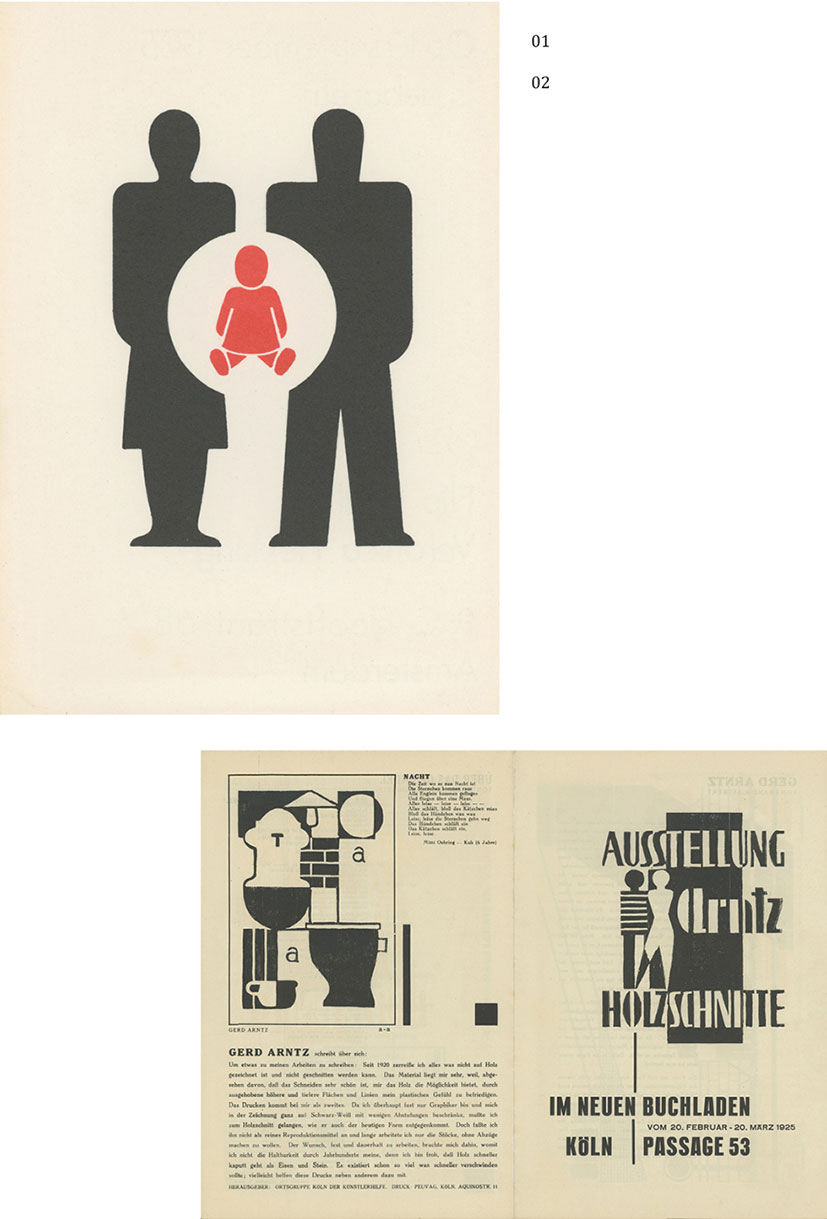
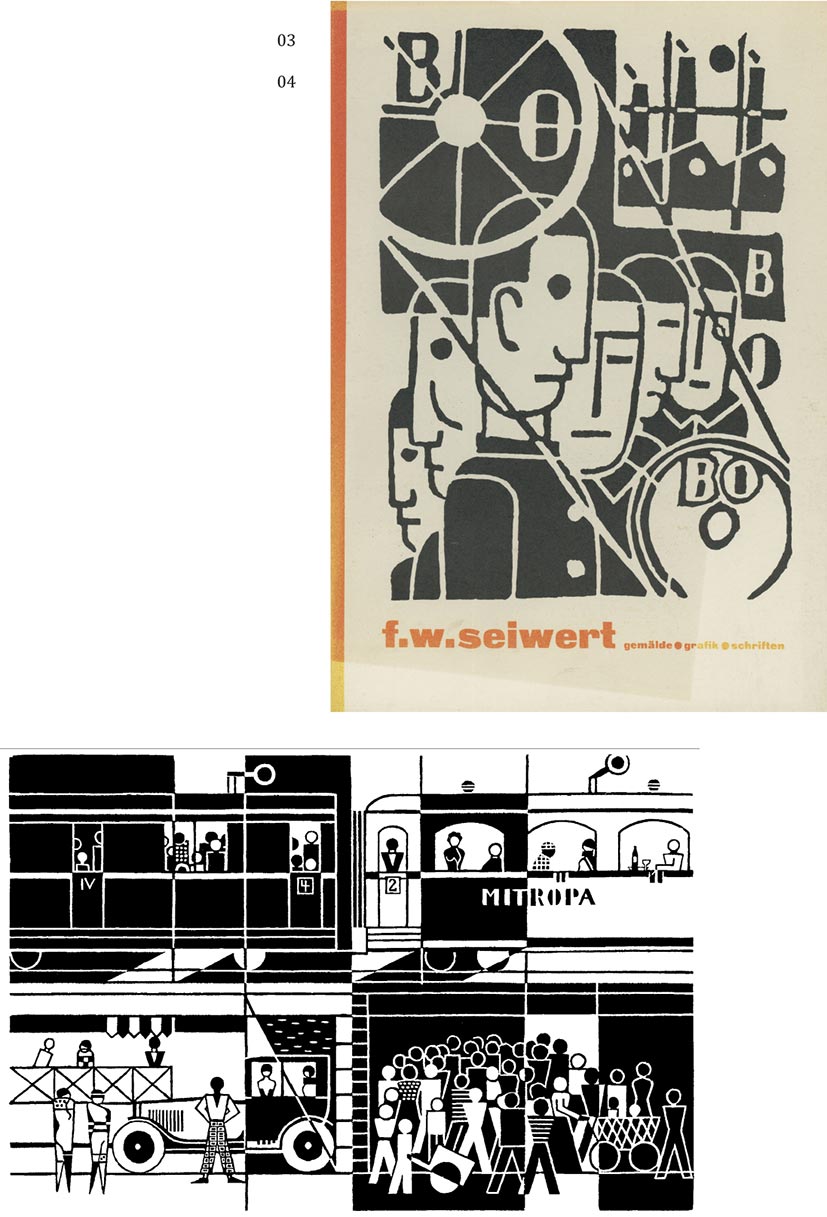
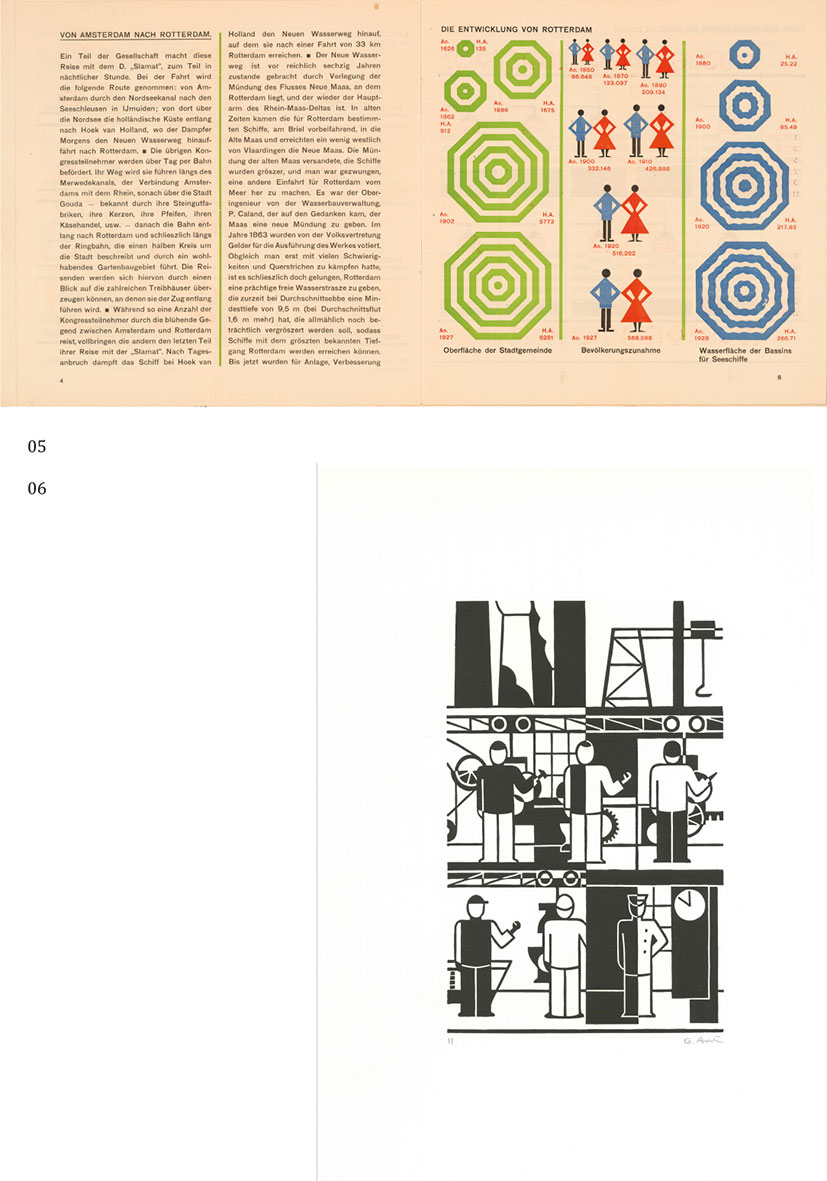
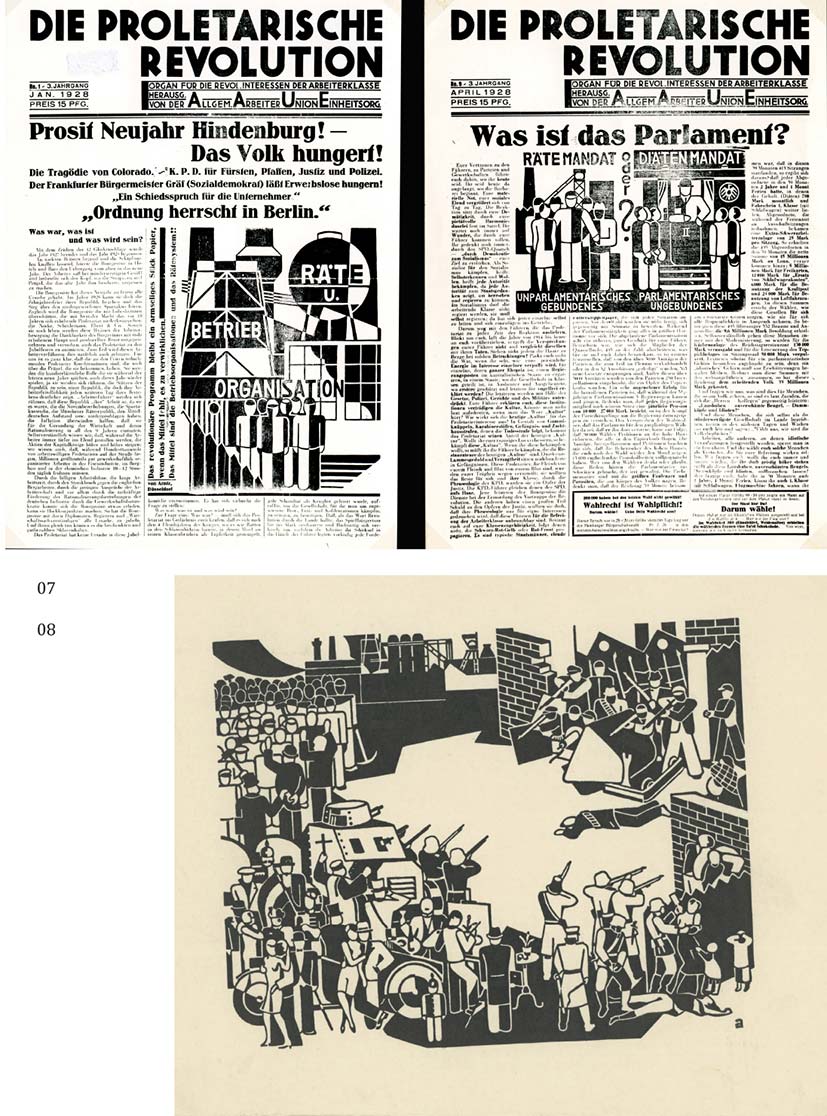
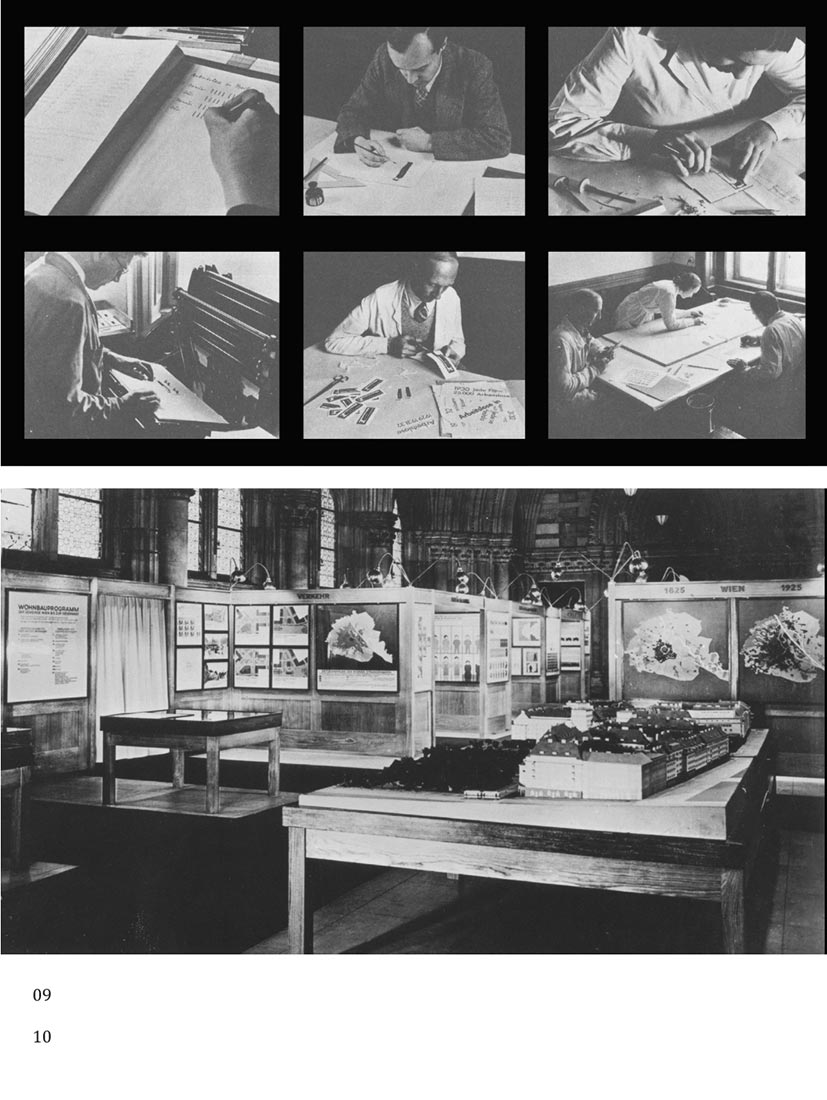
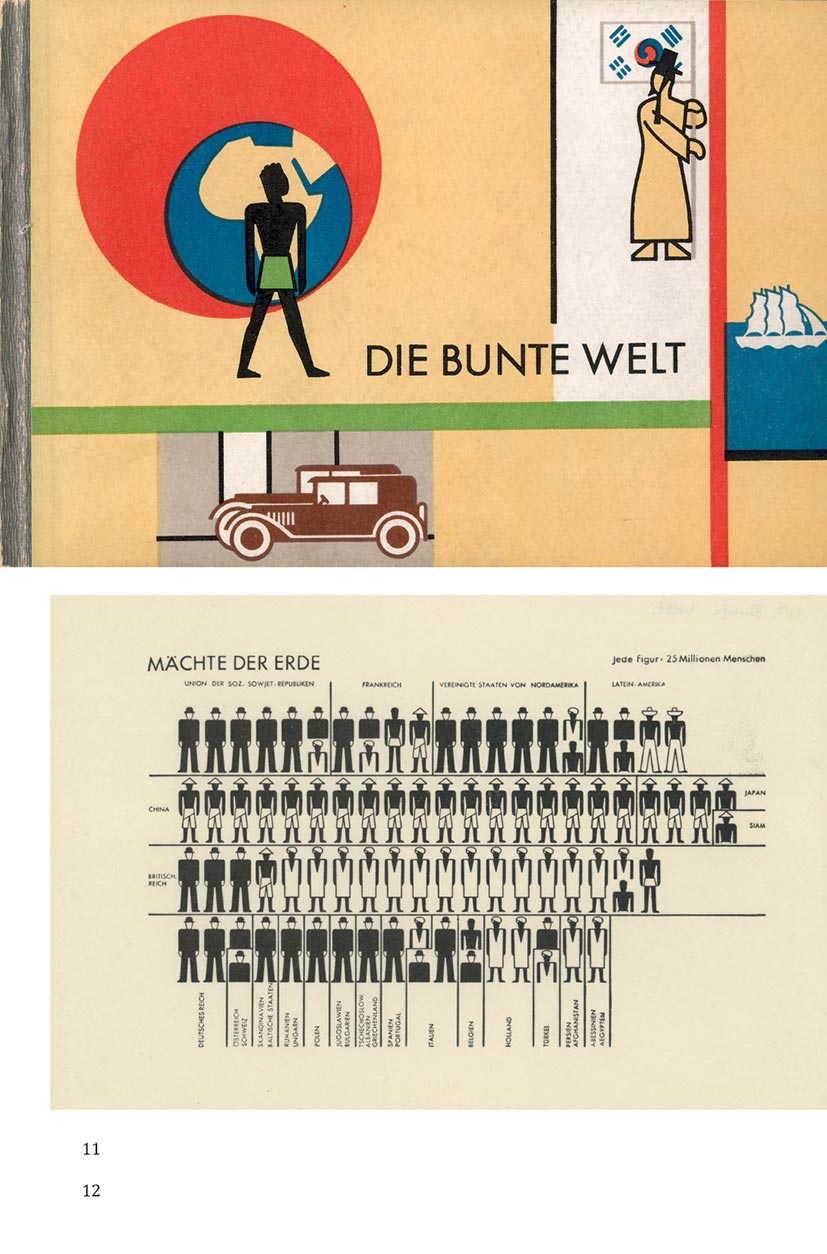
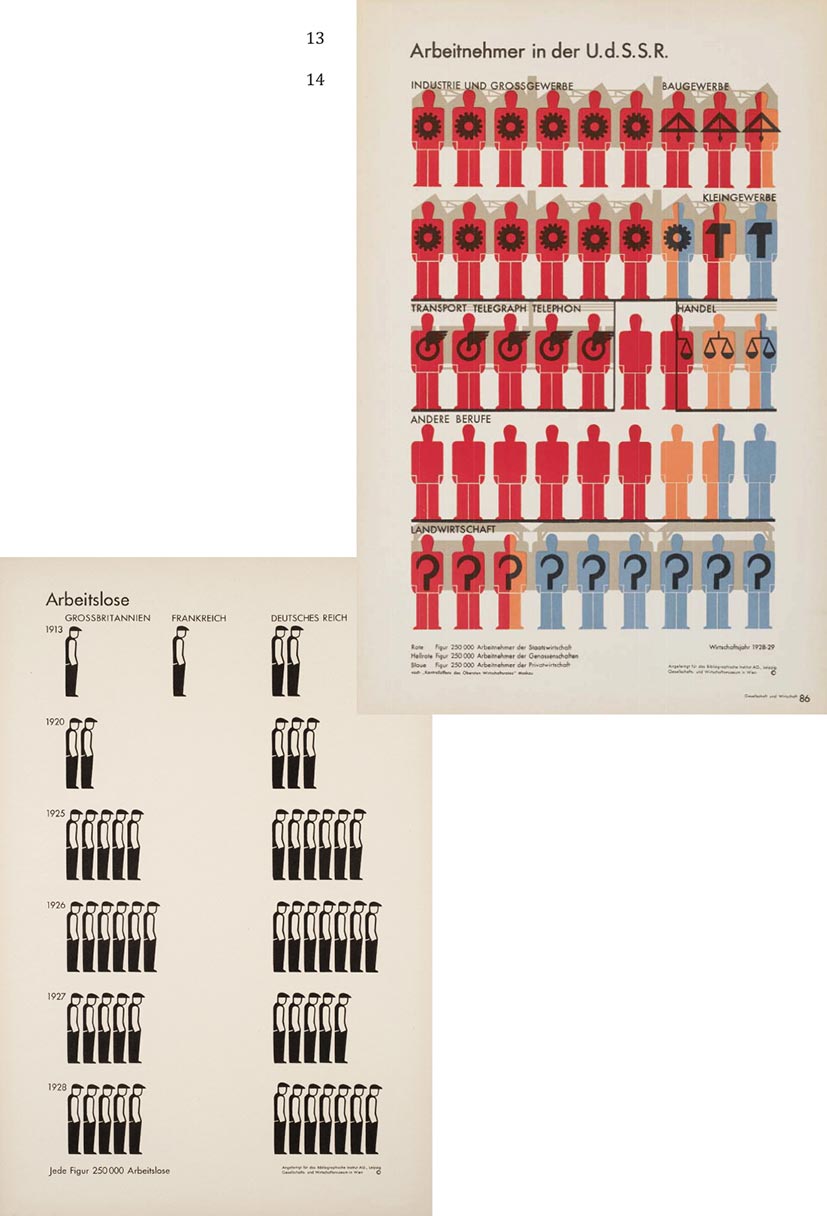
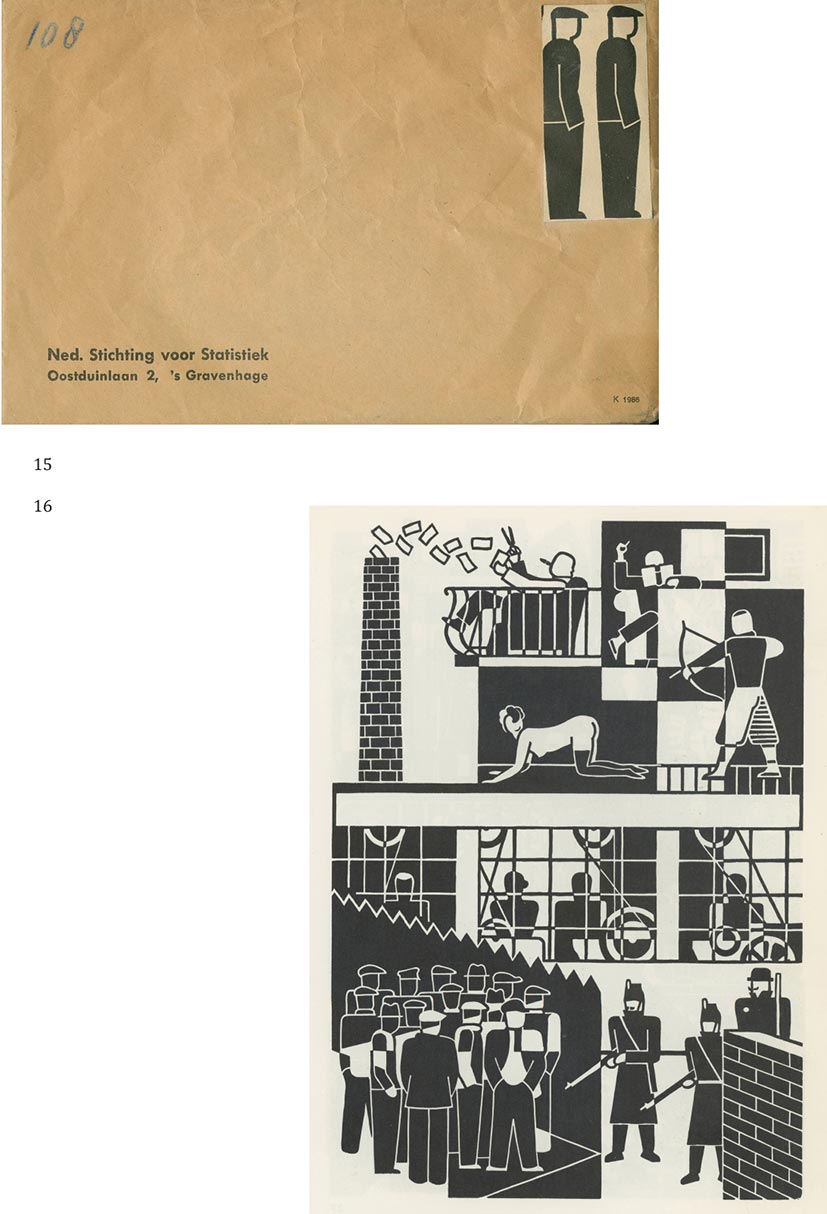
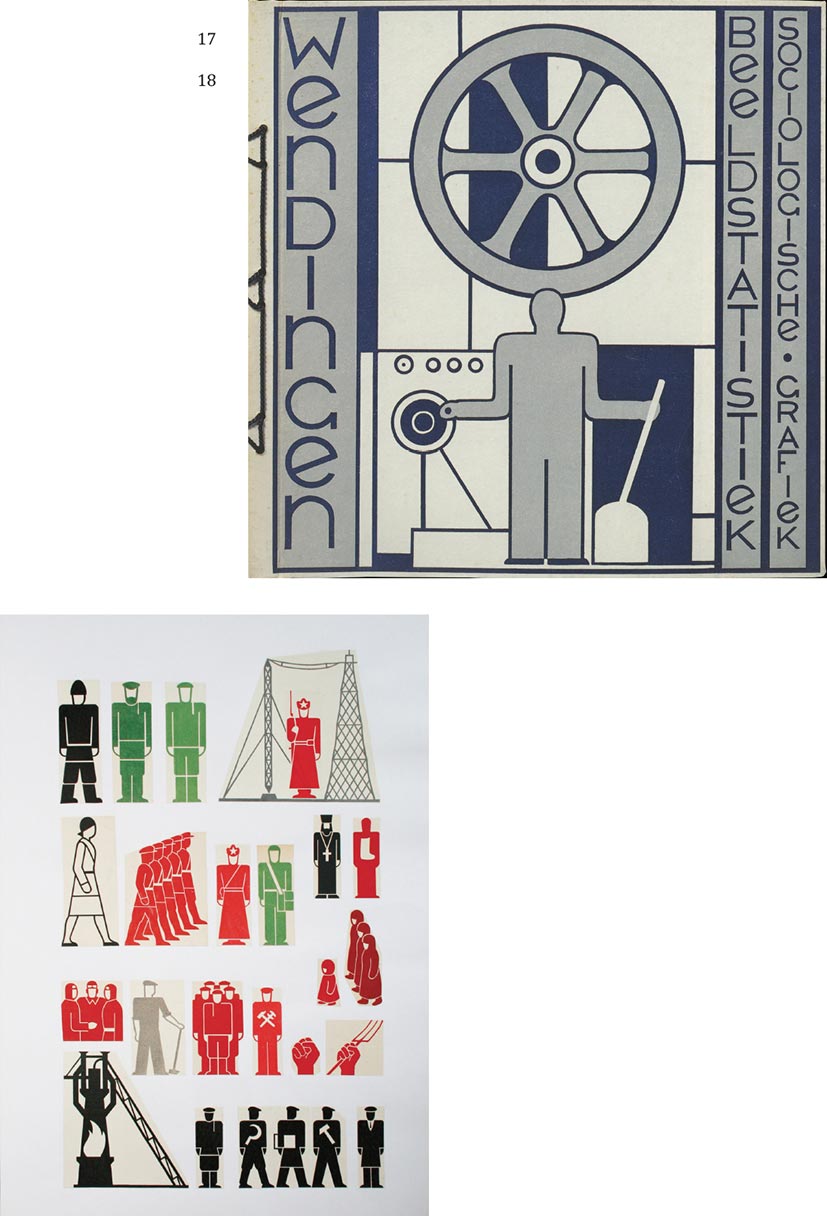
This would be his last print until 1931, because in early 1929 Neurath asked him and his family to move permanently to Vienna as head of the graphic department of the Gesellschafts- und Wirtschaftsmuseum. The museum also had a scientific department collecting the social and economic facts, which a special team subsequently ‘transformed’ into comparable entities representing fixed numbers, for which the graphic department designed the symbols for the realization of the ultimate charts. [Ill. 9] It was Arntz’ idea to cut them in linoleum, while before his arrival in Vienna the symbols were hand-drawn or cut out of paper. The final charts were presented in the museum or in exhibitions elsewhere and reproduced in books. [Ill. 10] The process of ‘transforming’ the scientific data was crucial before the charts could be designed. Marie Reidemeister — the later wife of Otto Neurath — played a key role in this process and retrospectively described it as follows:
‘*During the years in Vienna the team … usually consisted of the director, two transformers, two chief artists, and a number of technicians skilled in the work process. Among the scholars whom Neurath called in for their advice and research were experts in statistics, history, medicine, cartography, geography, engineering, industrial management, history of art, etc. This is how the team worked …: an idea was formed by Neurath; he discussed it with an expert to have his idea checked and to get suitable material. The transformer was present at such discussions, to get acquainted with the subject. The transformer then took over the material and developed the way to present it visually. The sketch (in pencil and colour pencils) was discussed with Neurath (and sometimes the expert) until a final rough version was agreed upon; this was … handed to the artist who took charge of design and finished artwork, in constant contact with Neurath and the transformer.’* (Quoted from Neurath/Kinross 2009, p. 77)
One of the earlier publications was *Die bunte Welt *[The Colourful World] from 1929, with a cover and some charts designed by Arntz. [Ill. 11] A visualization of ‘Powers of the World’ [Ill. 12], with each figure representing 25 million people, shows that the symbols were not yet as abstract as they would become later. An enormous commission was the loose-leaf atlas *Gesellschaft und Wirtschaft *with 100 colourful charts for the Bibliographical Institute in Leipzig, published in 1930. For the realization of this atlas the graphic team was extended with Peter Alma from Amsterdam and Augustin Tschinkel from Prague. Jan Tschichold was asked to provide typographic advice, resulting in the exclusive use of the new typeface ‘Futura’ of Paul Renner. Chart nr. 86 visualizes the ‘Employees in the USSR’. [Ill. 13] Each figure represents 250,000 employees: red in state economy, orange in co-operatives and blue in private economy. The figures concerned the economic year 1928-1929. Nr. 87 is a much simpler black-and-white chart that is one of the best-known, showing unemployment in Great Britain, France, and Germany between 1913 and 1928. [Ill. 14] In 1931 he even simplified this symbol [Ill. 15] and it is interesting to note how he used different versions in a privately made woodcut as ‘Arbeitslose’ [Unemployed] from 1931. [Ill. 16] The top half of this print shows how the upper class spends its leisure time.
Since the publication of the Gesellschaft und Wirtschaft atlas, the Viennese Method of Visual Statistics attracted more and more international attention. As a result, quite a number of younger collaborators started coming from abroad for short periods of time: among them Lotte Beese and Heinz Allner — students of the Bauhaus in Dessau — as well as the graphic designer Willem Sandberg, who became director of the Stedelijk Museum Amsterdam after the war. Among other publications, the Dutch party communist Peter Alma was responsible for a special issue of the magazine *Wendingen *about *’*Visual Statistics and Sociological Graphic Art’ in 1930. [Ill. 17] The fame of Otto Neurath’s new method of visual statistics also reached the Soviet Union.
In early 1931 Otto Neurath signed a contract for four years with the Russian government for a similar institute as the Gesellschafts- und Wirtschaftsmuseum, to be founded in Moscow under the name IZOSTAT. [Ill. 18] In order to fine-tune this contract Arntz first visited Moscow in November-December 1931. In his autobiographical text from 1988 he writes about this first visit: ‘*As an institute we first worked in the building of the State Publishing House Kusnetzkimost, with chief Chalatow as our connection with the executive committee, that was our direct commissioner. I went to see a Mayakovsky-exhibition, being the only visitor. When I said at the institute that the exhibition impressed me, some Russian colleagues didn’t want to talk about Mayakovsky, who was already banned. When there was no interpreter we mainly spoke German or French with each other, more or less cautiously. Very important for me was the renewed meeting with the Dutch engineer Wim de Wit and his wife Juscha, whom I knew since 1925 from Cologne…*’ (Arntz/Broos 1988, p. 31)
As a technical engineer Wim de Wit had worked in the Soviet-Union since 1929, but was later imprisoned in concentration camp Kolyma, where he was executed in 1938. As late as 1952 Arntz made a linoleum cut commemorating his death. He became friends with this leftist Dutch couple after they had moved to Aachen, because as a conscientious objector Wim de Wit couldn’t get a job in the Netherlands. Already in Aachen their house was an important meeting place for artists and politicians. This remained so in Moscow, where numerous other Dutch specialists lived and stayed for shorter or longer periods. In fact, there were so many that Arntz learned to speak Dutch during the next three periods that he lived and worked in Moscow until returning to Vienna in September 1933. His friend Peter Alma was leading the annex of IZOSTAT in Charkov and in the summer of 1933 they made a holiday trip to the Caucasus together. At that time Arntz did not have the faintest idea that the political developments in Vienna would force him, Neurath, and his institute to leave Austria for ever in the summer of 1934 and to emigrate to the Netherlands. From his new hometown The Hague he made his last trip to Moscow, from half October until early December 1934. Arntz describes the events in this period as follows:
‘*In the Netherlands I didn’t experience difficulties with my simplified representation of human figures and things in their social context. In the meantime, that clearly turned out to be the case in Moscow … The final ukase about art and artists associations had its effect on the IZOSTAT institute. “Why do your figures have no faces?” they asked. “Facelessness” was disapproved of by the party and also the too “western”, constructivist, “decadent” design was not in line with the newly dictated “socialist realism”. Some discussions followed with the management, that had tests carried out with more “Russian”-like figures. After the termination of our contract it wouldn’t take long before the “Viennese Method” came to an end and the IZOSTAT institute declined into another style.*’ (Arntz/Broos 1988, p. 37)
This last remark of Arntz may be true. But looking at the few publications of IZOSTAT in public Dutch collections, already as early as 1932 I noted the presence of socialist-realist illustrations that absolutely contradicted the ideas of Neurath and Arntz. For example, the portfolio *Oe nas I oe nig *[About Us and About Them] in the collection of the Kunstmuseum Den Haag, which houses the largest collection of the free and applied graphic work by Arntz. [Ill. 19] Have these charts possibly been made while Neurath and/or Arntz were not present in Moscow? I have no idea and am curious to find out more about this.
For the friends among his collaborators at his farewell Arntz had made the woodcut ‘Russia 1934’, showing the ‘progression’ of collectivization under the leadership of the Communist party. [Ill. 20] But in the end he didn’t take the print with him to Moscow, fearing danger for his friends. Arntz used more or less the same organization of the picture plane for the first print he made in the Netherlands: ‘The Third Reich’, 1934. Later more about this crucial print. Back in the Netherlands, Arntz asked Wim and Juscha de Wit to bring him a copy of Aviacija i Vozdukhoplavaniya [Aviation and Ballooning] on their next trip to Holland. [Ill. 21] Since the collaboration between the Gesellschafts- und Wirtschaftsmuseum and Moscow had ended, pictorial statistics continued to be an important element in publications in the USSR; even as late as 1939 considering *An Album Illustrating the State of Organization and National Economy of U.S.S.R. *with visual statistics designed by El Lissitzky. [Ill. 22]
After the cruel crushing of the Viennese Schutzbund-revolt in February 1934 by the fascists, the Social-Democrats were side-tracked and the Museum für Gesellschaft und Wirtschaft had to close its doors. Arntz represented these events in his woodcut ‘Vienna 1934’. [Ill. 23] With a diminished staff and without any financial government support the institute, for the time being, found a safe home base in The Hague, under the names ‘International Foundation for Visual Education’ or ‘Mundaneum The Hague’. Being emigrants they at first had a hard time getting commissions. Because the denomination ‘Viennese Method of Pictorial Statistics’ wasn’t functional anymore, an alternative name had to be found. This resulted in ISOTYPE, an abbreviation of ‘International System of Typographic Picture Education’ and in Greek meaning ‘always the same sign’. Arntz designed a new logo that was first reproduced in the pioneering booklet *International Picture Language. The First Rules of Isotype *by Otto Neurath, published in London in 1936. [Ill. 24] Under the slogan ‘Words divide, pictures connect’ Otto Neurath and his team describe and show how symbols are not only useful for visual statistics, but in the form of pictograms can also help international communication. Neurath himself didn’t say so, but Isotype can be considered as a visual form of Esperanto.
Next to his work for the new institute Arntz privately continued to make political prints. For the first time using linoleum for ‘Habsburger Restauration’ in 1934, representing the threatening Habsburg restoration by the Austrian nationalist chancellor Engelbert Dolfuss, who was later murdered. [Ill. 25] In 1935-1936 Arntz published several political prints in the magazine *De Arbeidersraad *[Workers’ Council], allied to the German General Workers Union, Unit Organization he had been affiliated with since the early 1920s. One of these was the aforementioned ‘The Third Reich’ from 1934. [Ill. 26] Using the pseudonym ‘Dubois, Paris’ Arntz showed an enlargement of this print at the Amsterdam exhibition ‘D.O.O.D’ [Death], an abbreviation of ‘De Oympische Spelen Onder Dictatuur’ [The Olympics under Dictatorship] as a protest against the Olympic Games of 1936 in Berlin. But the police removed this image from the exhibition as an insult against a befriended head of state.
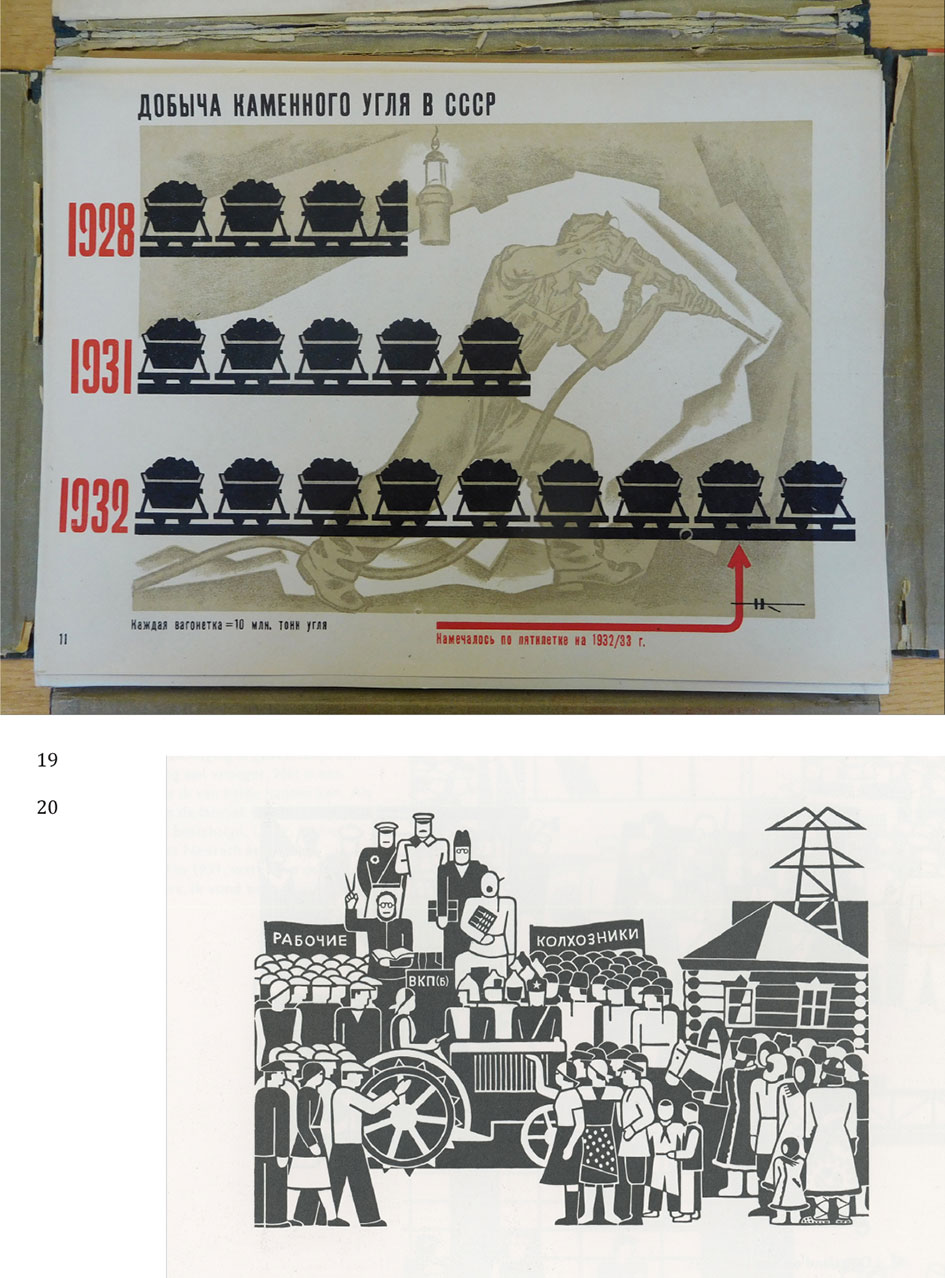
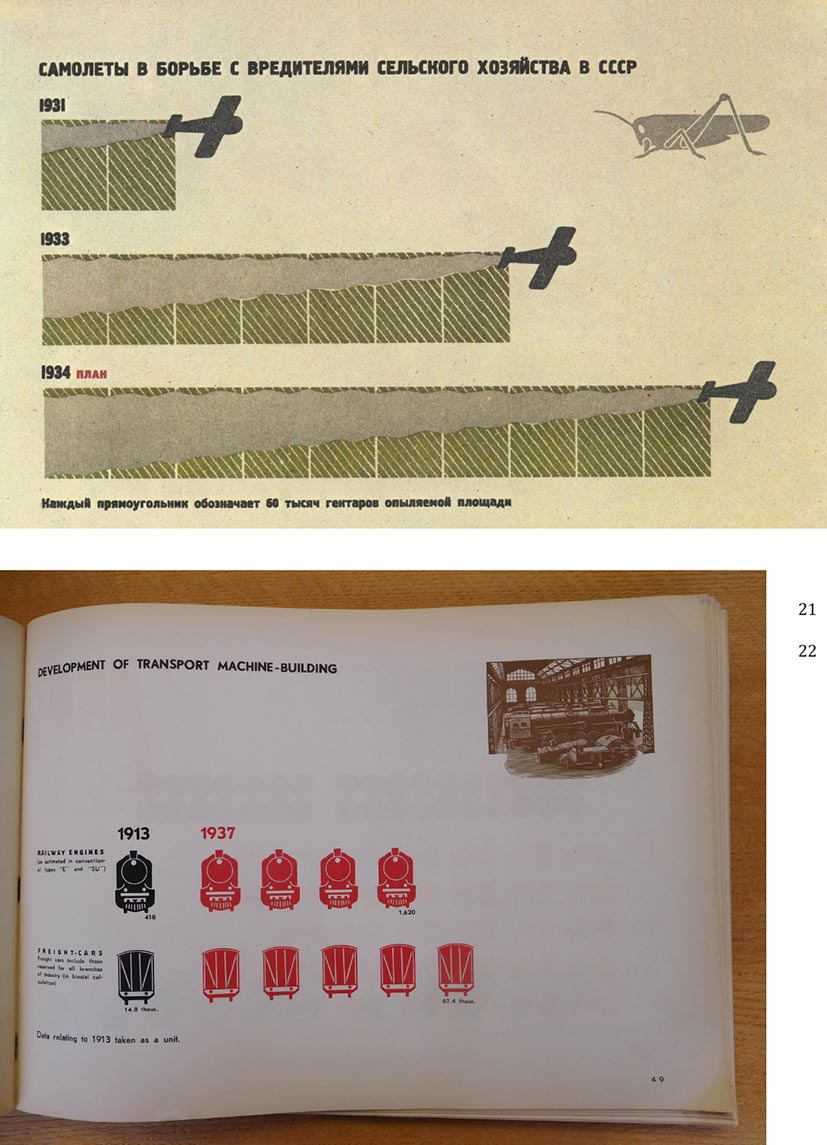
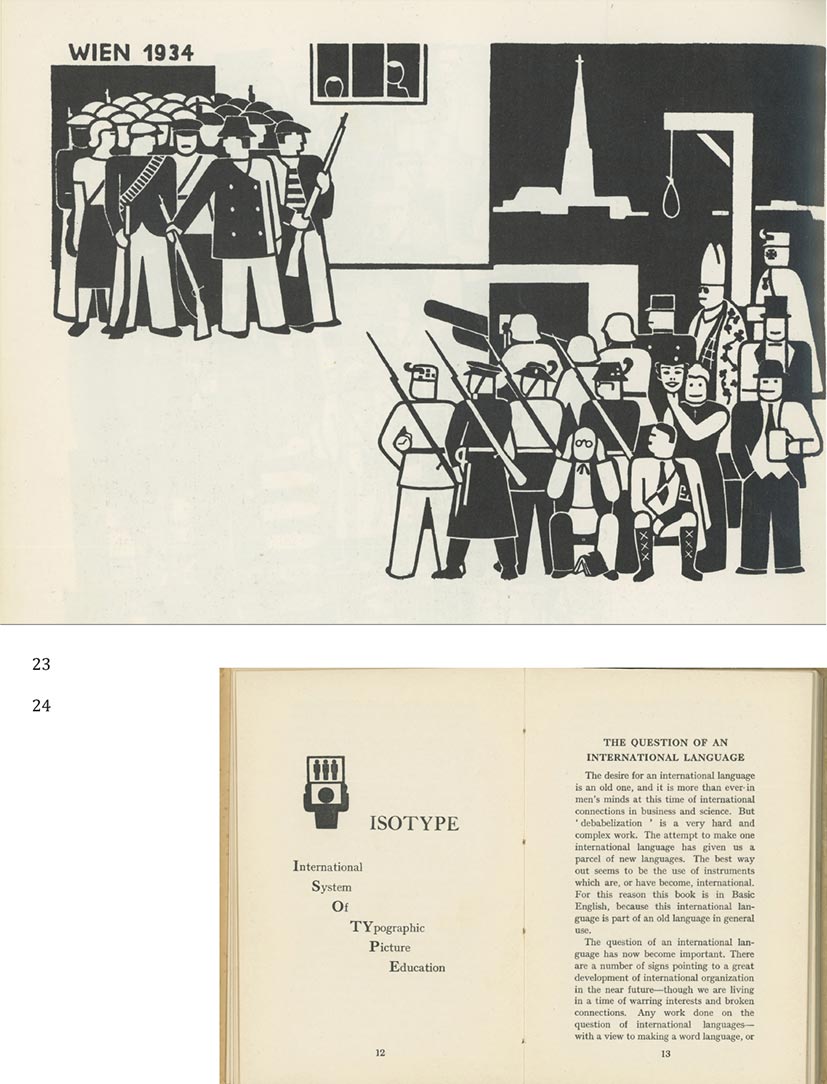
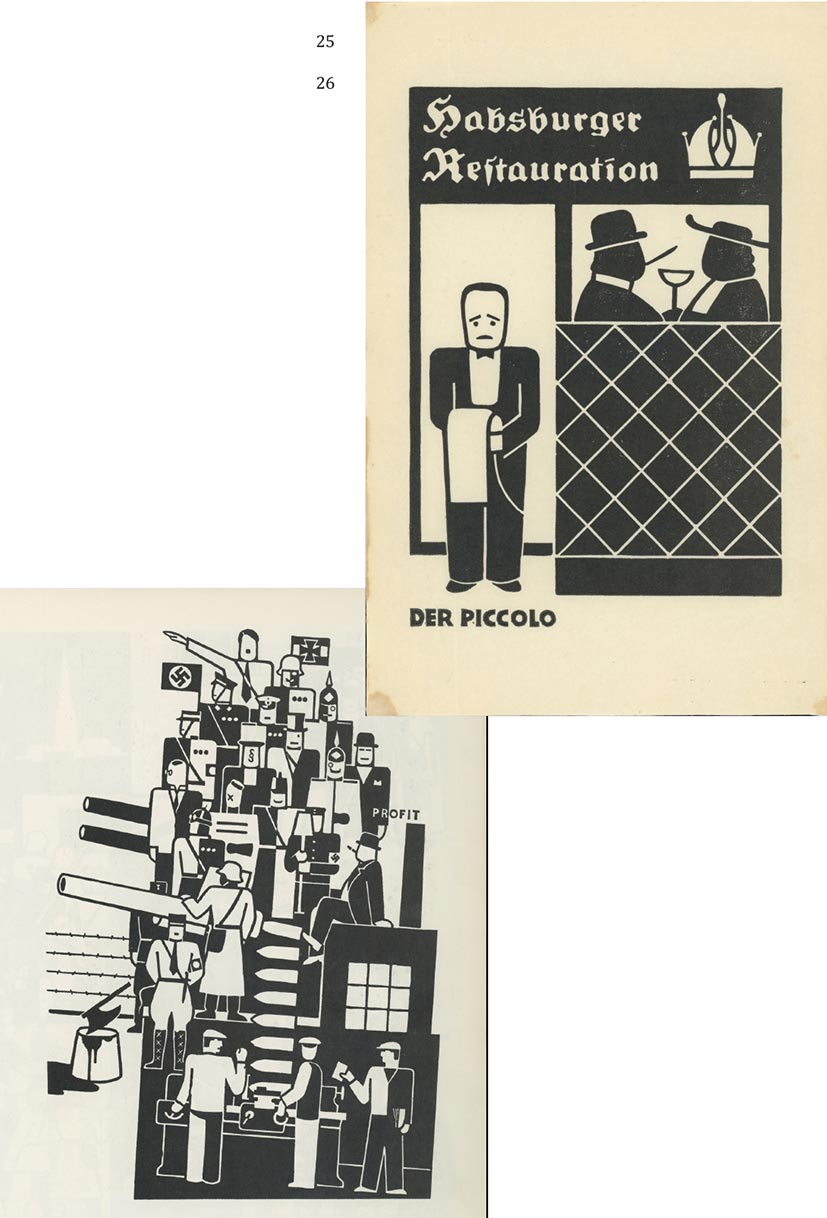
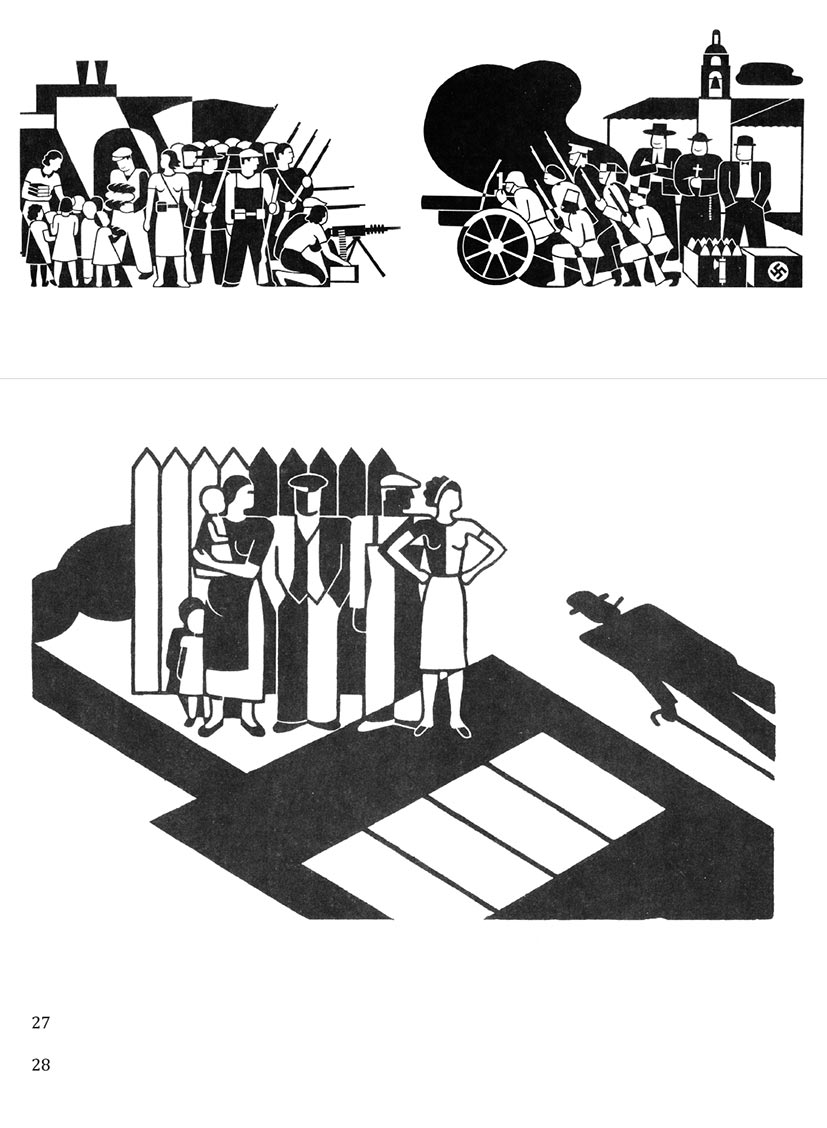
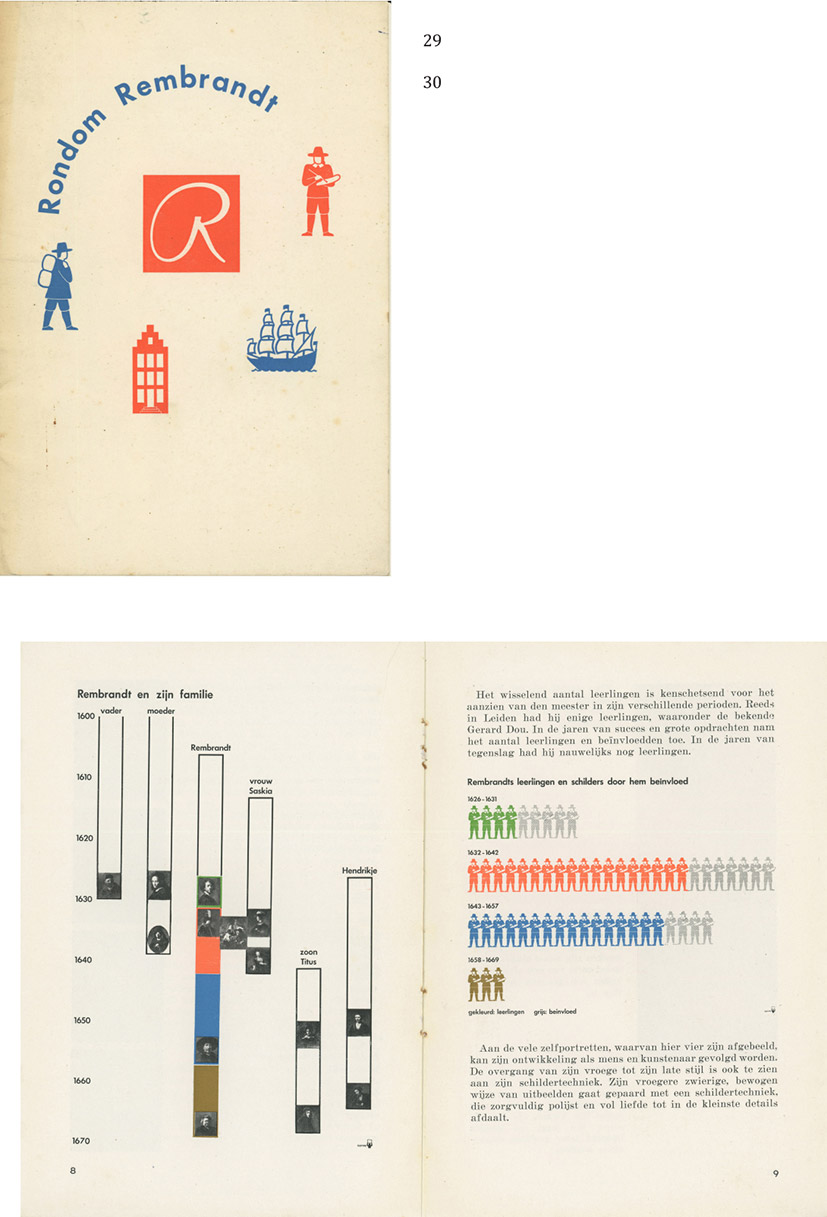
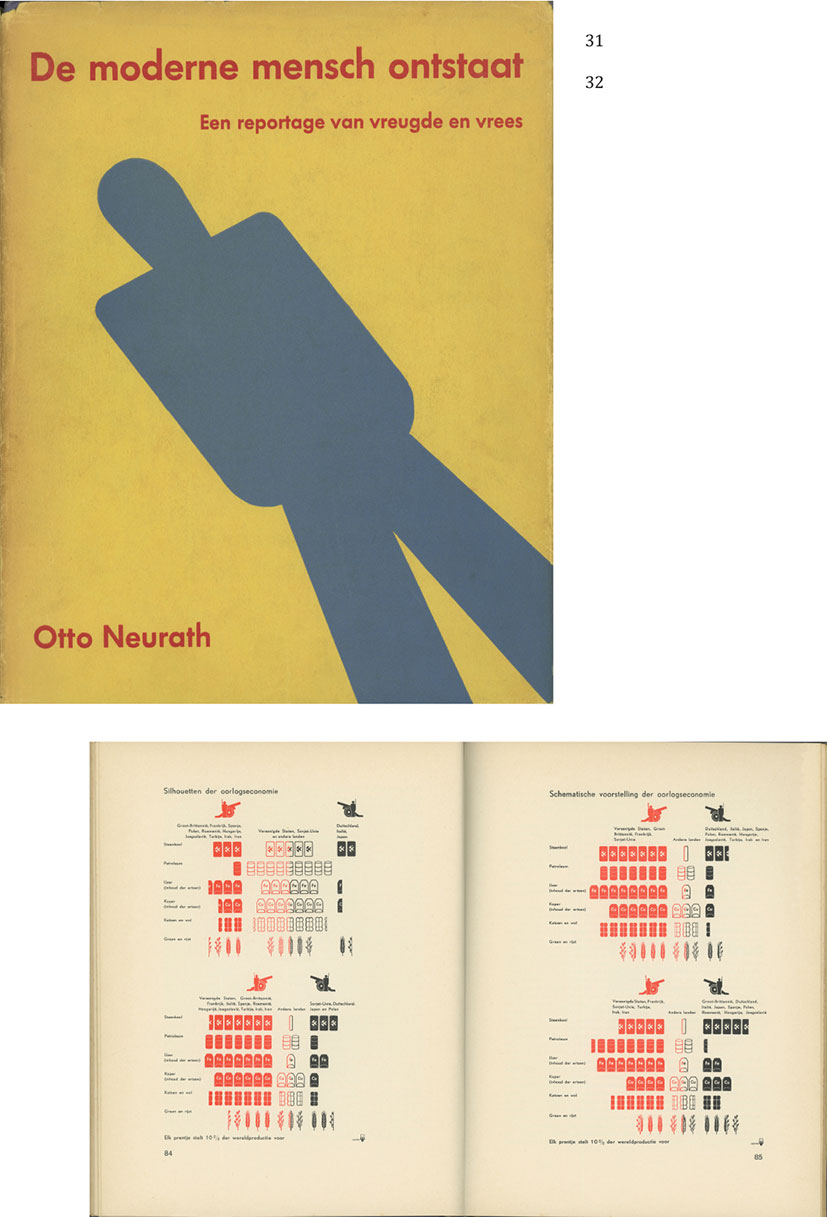
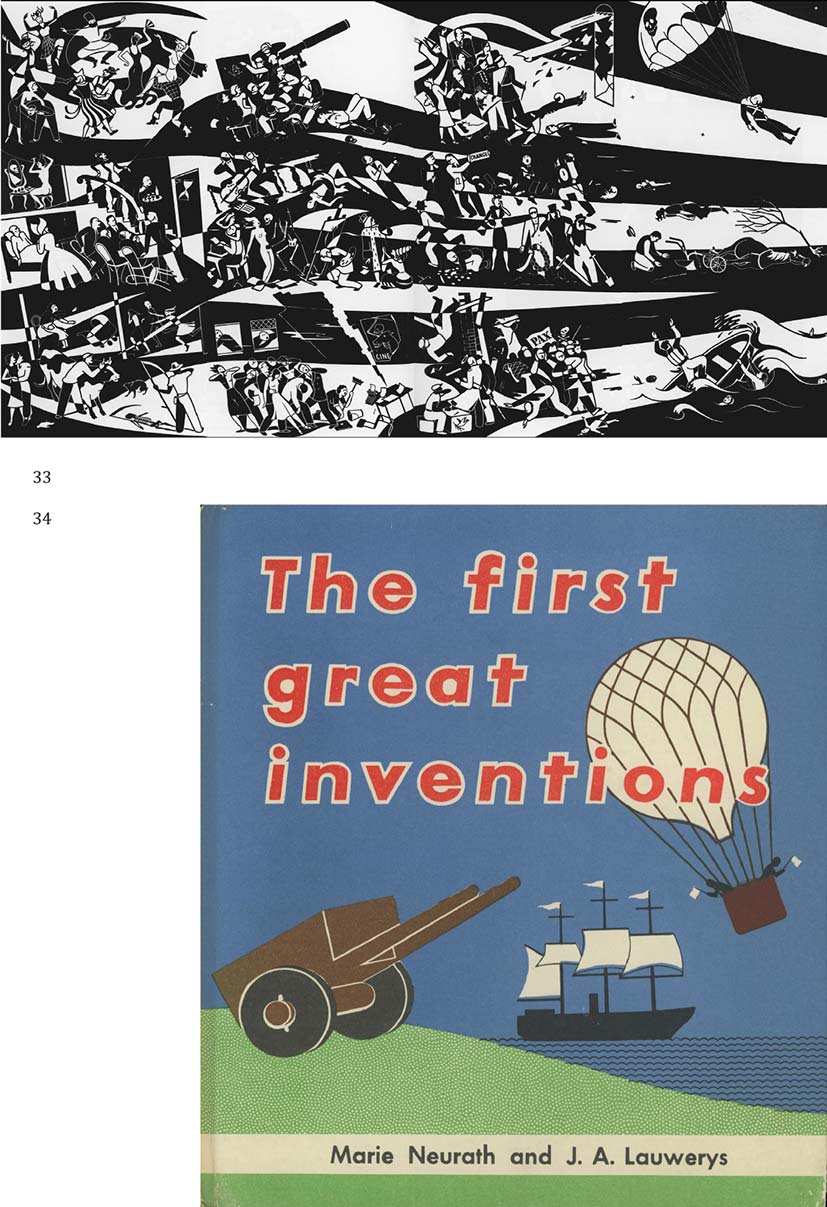
In leftist circles the outbreak of the Spanish Civil War in 1936 was a clear foreshadowing of the Second World War. This was also true for Gerd Arntz, considering his linocuts ‘Spanien links’ [Spain Left] and ‘Spanien rechts’ [Spain Right]. [Ill. 27] Since Hitler had taken over power in 1933, the hope for revolutionary changes in society dwindled more and more. This had its effect on the international avant-garde and brought about a change in subject matter and style for many progressive artists, including Arntz. From the mid-1920s he had developed an utmost simplified figurative-constructive style to express his revolutionary political ideas. But from 1935 onwards he more and more chose for linoleum instead of wood for his prints and we gradually see a shift in his work from an uncompromising geometrical style to a much more informal language of form. In 1938 he made his last series of woodcuts under the title ‘Lehrbilder’ [Learning prints]. Planned as a series of twelve, he only realized eight of them. For the last time until 1950 the subject-matter of this series is class-oppositions and anti-war protest, but in his own words after eight prints ‘I suddenly lost the courage’. [Ill. 28]
This gradual shift in style can also be noticed in the projects Neurath and his team would realize in the Netherlands. Two of the most important commissions were the exhibitions ‘Rondom Rembrandt’ [Around Rembrandt] in 1938 and ‘Het Rollende Rad’ [The Rolling Wheel] in 1939 — a promotional exhibition for the Dutch Railway Company. ‘Around Rembrandt’ was the first exhibition in the Netherlands highlighting ‘classical art’ in an educational manner. [Ill. 29] With maps the historical events and social-economic conditions of the Golden Age were illustrated. Visual statistics and photographs summarized the life and work of Rembrandt in a highly organized form. [Ill. 30]
In the meantime, new contacts were established in the Anglo-Saxon world. Contacts with Alfred Knopf’s publishing house resulted in an open commission for Otto Neurath to realize a book according to his own insights. This resulted in Modern Man in the Making, from 1939 onwards successively published in the United States, England, the Netherlands, and Scandinavia. [Ill. 31] It was a ground-breaking publication with 100 illustrations in seven colours showing the possibilities of ISOTYPE in optima forma. But the subtitle expressed the threatening situation in the world: *A Reportage of Joy and Fear. *Looking back, Arntz was particularly satisfied with charts about war economics at the eve of the Second World War. These charts on p. 84-85 [Ill. 32] show speculations on alliances for the next war, based on the power over raw materials since 1929 with each symbol representing 10 per cent of the world production. They show how the balance of power shifts dramatically, depending especially on which side the United States and the Soviet Union would choose.
Because of the unexpected German invasion of the Netherlands in 1940, Modern Man in the Making turned out to be the last joint project of Neurath and Arntz; the last time they together could combine a democratization of knowledge with a democratic form of design. One week after the German invasion Otto Neurath and Marie Reidemeister were able to escape to England at the very last moment, on 17 May, leaving Gerd Arntz and his family behind. Through the newly founded Nederlandse Stichting voor Statistiek [Netherlands Foundation for Statistics] Arntz was able to continue his statistical work in the first years of the German occupation but ultimately he couldn’t avoid being called up for military service in the German army and thus he served in a world war for the second time. Otto Neurath and Marie Reidemeister continued their work in London from 1942 as the Isotype Institute and after the death of Otto Neurath she continued his work until the early 1970s. Arntz continued his work in the field of visual statistics until his retirement in 1965. In addition to this professional work he privately continued to make linocuts. But most of his prints deal with the situation in the world in a more general sense. In an interview from 1973 he explained this as follows:
‘*I always kept the sour feeling that we — the groups of council communists from the time of crisis — had our chances when the time was ripe for it; those chances are gone nowadays and I have no idea how they might come again in this system. … The true bottlenecks do no longer concern the relations between proletariat and bosses, but have become global. It’s now about rich and poor countries.*’ (Den Haag 1976, pp. 71-72)
After a side-trip of ten years into classical history, in 1950 the Korean War nevertheless inspired Arntz to create a series of twelve prints under the title ‘Totentanz’ [Death Dance]. [Ill. 33] The idea for this series came from prints made by Hans Holbein the Younger in 1538, but Arntz placed them in a contemporary situation. By joining the twelve prints into one piece of 63 x 120 cm it appears that death — coming from the right and hitting all nations and strata of society — is caused by mankind itself by means of the atomic bomb with from the top right to the lower left: Dance of the Nations, in Town, in the Village, the Scientists, the Artists, the Employees, the Rulers, the Traders, the Workers, in the Air, on the Earth and lastly in the Water.
The Russian invasion of Hungary and the Algerian War of Independence were other conflicts that inspired Arntz to make linocuts, like ‘Death Dance’ without any direct reference to specific military actions. In his later years, Arntz clearly lost the hope that his prints could contribute to real changes in society. In the meantime, Marie Neurath-Reidemeister continued her work in London, publishing a great number of educational books such as, for example, The First Great Inventions, London 1951. [Ill. 34] She did so without the help of Gerd Arntz, but these publications are still of an incredible beauty and an interesting post-war side result of the groundbreaking ‘Viennese Method of Visual Statistics’.
Flip Bool, December 2020
—*
The text is based on a lecture held on the closing day of the exhibition *IZOSTAT *at the Na Shabolovke Gallery, Moscow, 16 December 2018. It has been published at www.designhistory.nl, the Dutch online magazine / platform of the Dutch Design History Society in 2019, now slightly revised for DESIGNABILITIES. By this exhibition I learned about the existence of a separate branch of IZOSTAT in Leningrad that functioned more or less independently from the head quarter in Moscow. The graphic designer Ben Faydherbe was so kind as to help with the scans. Sincere thanks to Anouk and Thomas Arntz of the Gerd Arntz Estate for kindly waiving the copyrights.
References
# Literature
**Arntz**, Gerd / **Broos**, Kees (red.) (1988): *Gerd Arntz. De tijd onder het mes. **Hout & linoleumsneden 1920-1970*, Nijmegen.
**Arntz**, Gerd / **Tschinkel**, Augustin (1934): *f.w. seiwert. gemälde. grafik. schriften*, Prague.
**Bool**, Flip / **Broo**, Kees (red.) (1976): *Gerd Arntz. Kritische grafiek en beeldstatistiek*, tent. cat. Den Haag (Haags Gemeentemuseum)
**Neurath**, Marie / **Kinross**, Robin (2009): *The transformer: principles of making Isotype charts*, London.
.
# Illustrations (Gerd Arntz)
1. Birth announcement for Cas Bool, September 10, 1975woodcuts
2. Folder for the Ausstellung Arntz Holzschnitte im neuen Buchladen (Exhibition of Arntz’s woodcuts in the New Bookshop), Cologne 1925woodcuts
3. Cover of f.w. seiwert – gemälde.grafik.schriften (paintings, prints, texts), Prague 1934woodcuts
4. Mitropa, woodcut 1925woodcuts
5. N.P. de Koo, brochure about the port of Rotterdam, pp. 4-5, 1929woodcuts
6. Fabrik (Factory), 1927, woodcuts
7. Räte u. Betrieb Organisation \en\ Rätemandat oder Diätenmandat, 1927-1928 on the title pages of Die Proletarische Revolution (The Proletarian Revolution), 3 (January 1928) 1 en 3 (April 1928) 9 woodcuts
8. Bürgerkrieg (Civil war), 1928, woodcut, first statewoodcuts
9. Photos showing the process of creating a chartwoodcuts
10. Presentation of the Gesellschafts- und Wirtschaftsmuseum in the Vienna city hall, ca. 1927woodcuts
11. Cover of Die bunte Welt (The Colorful World), 1929woodcuts
12. Chart 'Mächte der Erde' (Powers of the World) in Die bunte Welt (The Colorful World), 1929woodcuts
13. Atlas Gesellschaft und Wirtschaft, 1930, page 86, 'Arbeitnehmer in der U.d.S.S.R.' (Workers in the USSR)woodcuts
14. Atlas Gesellschaft und Wirtschaft, 1930, page 87, 'Arbeitslose 1913-1928. Grossbritanien, Frankreich, Deutsches Reich' (The unemployed 1913-1928. Great Britain, France, German Reich)woodcuts
15. Symbol 108 of an unemployed worker of the Netherlands Foundation for Statistics, coll. Kunstmuseum Den Haag (Art Museum The Hague)woodcuts
16. Arbeitslose (Unemployed), 1931, woodcuts
17. Peter Alma, cover of Wendingen, 11 (1930)woodcuts
18. Symbols for IZOSTATwoodcuts
19. Chart from About us and about them, Izostat, Leningrad 1932woodcuts
20. Russland 1934, woodcuts
21. Chart 34 from Aviation and Ballooning, Moscow 1934woodcuts
22. El Lissitzky, Chart of the 'Development of transport machine building' in the USSR. An Album Illustrating the State Organization and National Economy, Moscow 1939, plate 11woodcuts
23. Wien (Vienna) 1934, woodcuts
24. Otto Neurath, International Picture Language. The First Rules of Isotype, London 1936, p. 12 with Isotype logowoodcuts
25. Habsburger Restauration, 1934, linocutwoodcuts
26. Das Dritte Reich, 1934, woodcuts
27. Spanien links, Spanien rechts (Spain Left, Spain Right) 1936, woodcutswoodcuts
28. Schatten (Shadow), 1938, woodcuts
29. Cover of the brochure Rondom Rembrandt (Around Rembrandt), 1938woodcuts
30. Brochure Rondom Rembrandt (Around Rembrandt), 1938, pp. 8-9 with 'Rembrandt and his family' and 'Rembrandts pupils and painters influenced by him'woodcuts
31. Dust jacket of Otto Neurath, De Moderne Mensch Ontstaat (Modern Man in the Making), Amsterdam 1940woodcuts
32. Otto Neurath, De Moderne Mensch Ontstaat (Modern Man in the Making), Amsterdam 1940, pp. 84-85 met 'Silhouets of the war economy' and 'Schematic representation of the war economy'woodcuts
33. Dodendans (Death Dance), 1950, twelve linocutswoodcuts
34. Cover of Marie Neurath, J.A. Lauwerijs, The First Great Inventions, London 1951woodcuts
Download & Citation Info
Bool, Flip (2020): Democratic Graphics – The political and graphic work of Gerd Arntz 1920–1940. In: DESIGNABILITIES Design Research Journal, (12) 2020 https://tinyurl.com/yyr3b8zk ISSN 2511-6274